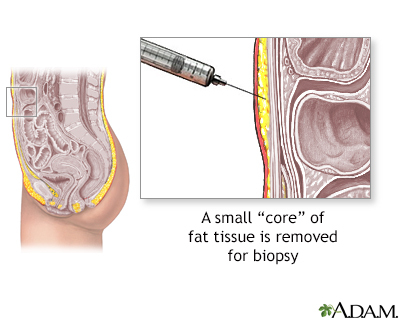Abdominal wall fat pad biopsy
Definition
An abdominal wall fat pad biopsy is the removal of a small part of the abdominal wall fat pad for laboratory study of the tissue.
Alternative Names
Amyloidosis - abdominal wall fat pad biopsy; Abdominal wall biopsy; Biopsy - abdominal wall fat pad
How the Test is Performed
Needle aspiration is the most common method of taking an abdominal wall fat pad biopsy.
The health care provider cleans the skin on your belly area. Numbing medicine will be applied on the area. A needle is placed through the skin and into the fat pad under the skin. A small piece of the fat pad is removed with the needle. It is sent to a laboratory for analysis.
How to Prepare for the Test
No special preparation is usually necessary. However, follow any specific instructions your provider gives you.
How the Test will Feel
You may have some mild discomfort or feel pressure when the needle is inserted. Afterward, the area may feel tender or be bruised for several days.
Why the Test is Performed
The procedure is done most often to test for amyloidosis. Amyloidosis is a disorder in which abnormal proteins build up in tissues and organs, impairing their function. Clumps of the abnormal proteins are called amyloid deposits.
Diagnosing the disease in this way may avoid the need for a biopsy of a nerve or an internal organ, which is a more difficult procedure.
Normal Results
The fat pad tissues are normal.
What Abnormal Results Mean
In the case of amyloidosis, abnormal results mean there are amyloid deposits.
Risks
There is a slight risk for infection, bruising, or slight bleeding.
Gallery


References
Chernecky CC, Berger BJ. Biopsy, site-specific - specimen. In: Chernecky CC, Berger BJ, eds. Laboratory Tests and Diagnostic Procedures. 6th ed. St Louis, MO: Elsevier Saunders; 2013:199-202.
Gertz MA. Amyloidosis. In: Goldman L, Schafer AI, eds. Goldman-Cecil Medicine. 26th ed. Philadelphia, PA: Elsevier; 2020:chap 179.